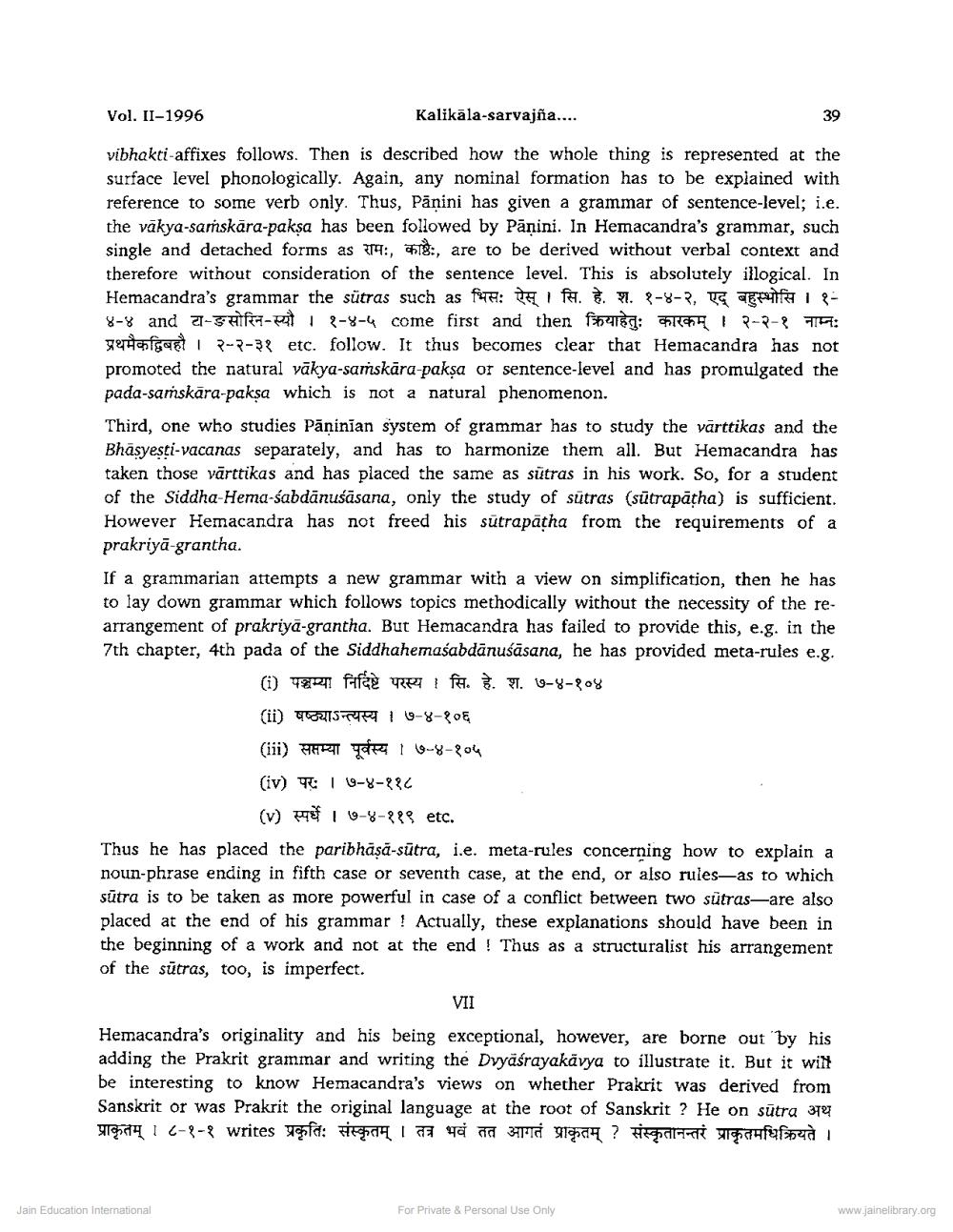Book Title: Kalikal Sarvagna Acharya Hemchandra A Re Appraisal Author(s): Vasant M Bhatt Publisher: Z_Nirgrantha_1_022701.pdf and Nirgrantha_2_022702.pdf and Nirgrantha_3_022703.pdf View full book textPage 5
________________ Vol. II-1996 Kalikāla-sarvajña.... 39 vibhakti-affixes follows. Then is described how the whole thing is represented at the surface level phonologically. Again, any nominal formation has to be explained with reference to some verb only. Thus, Pānini has given a grammar of sentence-level; i.e. the vākya-saṁskāra-paksa has been followed by Pāņini. In Hemacandra's grammar, such single and detached forms as 19., 18:, are to be derived without verbal context and therefore without consideration of the sentence level. This is absolutely illogical. In Hemacandra's grammar the sütras such as fie: teft. . 1. 8-8-8, T aerufi 8-8 and 2-5 Hifti 8-8-4 come first and then f5415c: I P-2- 716: gertati P--38 etc. follow. It thus becomes clear that Hemacandra has not promoted the natural vākya-saṁskāra-paksa or sentence-level and has promulgated the pada-samskāra-paksa which is not a natural phenomenon. Third, one who studies Pāṇinian system of grammar has to study the vārttikas and the Bhasyesti-vacanas separately, and has to harmonize them all. But Hemacandra has taken those vārttikas and has placed the same as sütras in his work. So, for a student of the Siddha-Hema-sabdānusāsana, only the study of sūtras (sūtrapātha) is sufficient. However Hemacandra has not freed his sūtrapātha from the requirements of a prakriyā-grantha. If a grammarian attempts a new grammar with a view on simplification, then he has to lay down grammar which follows topics methodically without the necessity of the rearrangement of prakriya-grantha. But Hemacandra has failed to provide this, e.g. in the 7th chapter, 4th pada of the Siddhahemaśabdānušāsana, he has provided meta-rules e.g. (i) R fafè ref . 1. 19-8-808 (ii) url I 1-8-80€ (iii) HR TREI 1-8-8044 (iv) 4 1 10-8-886 (v) -8-889 etc. Thus he has placed the paribhasa-sūtra, i.e. meta-rules concerning how to explain a noun-phrase ending in fifth case or seventh case, at the end, or also rules-as to which sutra is to be taken as more powerful in case of a conflict between two sutras-are also placed at the end of his grammar ! Actually, these explanations should have been in the beginning of a work and not at the end ! Thus as a structuralist his arrangement of the sūtras, too, is imperfect. VII Hemacandra's originality and his being exceptional, however, are borne out by his adding the Prakrit grammar and writing the Dvyaśrayakävya to illustrate it. But it will be interesting to know Hemacandra's views on whether Prakrit was derived from Sanskrit or was Prakrit the original language at the root of Sanskrit ? He on sūtra 372 प्राकृतम् । ८-१-१ writes प्रकृतिः संस्कृतम् । तत्र भवं तत आगतं प्राकृतम् ? संस्कृतानन्तरं प्राकृतमधिक्रियते । Jain Education International For Private & Personal Use Only www.jainelibrary.orgPage Navigation
1 ... 3 4 5 6 7 8
